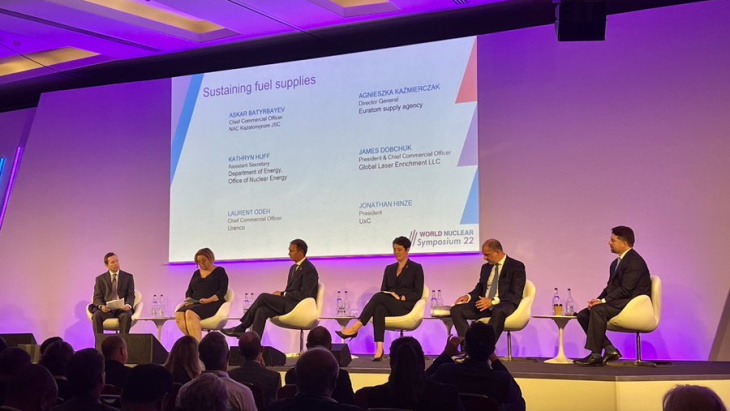A bright outlook for nuclear will mean a growing demand for fuel, said session chair Jonathan Hinze, president of UxC. He asked high-level panellists from industry and government how if they have any concerns about the future adequacy of nuclear fuel, as well as if - and where - they see future pinch-points.
Recent events have led to a new market reality, Euratom Supply Agency Director General Agnieszka Kaźmierczak said, with shorter to medium term risks dominated by the need for alternatives to Russian-supplied fuel for VVER reactors, and transport issues. These risks are already being mitigated, as work has been under way for some time to develop alternative sources of fuel supply and different transport routes.
Longer term risks need to be seen from a global, rather than European level, she said. Conversion is a particular risk: "If we look at conversion capacity in the open market, in 10, 20 years that capacity would not be sufficient to cover the needs as we see them now," she said - and those needs will rise, needing a coordinated response on a global level. "We are advocating for an assessment of capacity not only in conversion capacity but also in uranium production and enrichment," she said.
"We need diversification at all stages of the fuel cycle and perhaps more than ever," she said. Long periods of low prices led to a lack of investment in conversion capacity, which now needs to be ramped up.
The US government is "fully activated, determined and focused" on developing a domestic supply chain for its existing and future fleet, Assistant Secretary Kathryn Huff of the US Department of Energy Office of Nuclear Energy said. The US has moved quickly to make some immediate investments in reducing near-term risk to enrichment capacity, with the Inflation Reduction Act supporting high-assay low-enriched uranium and fuel supply chains generally, but she agreed that conversion is the most urgent bottleneck worldwide and capacity needs to be increased rapidly.
"Everything needs to start now if we're going to be ready in time to meet the coming challenges," she said, adding that it is imperative for the USA to be able to meet a sufficient portion of its own supply chain. "Until we regain that capability, we have a lot of work to do," she said.
Nuclear industry panellists also identified conversion and transport as the main pinch points. For the last ten years or so - since the Fukushima Daiichi accident - "we've been living off inventories", Urenco Ltd Chief Commercial Officer Laurent Odeh said. But since February - when Russian action began in Ukraine - that flexibility has quickly vanished. Urenco is preparing for a potential ramp-up of enrichment capacities.
Askar Batyrbayev, chief commercial officer of NAC Kazatomprom JSC, also pointed to interest from financial players creating unconventional demand as a potential pinch-point. With growing numbers of financial players interested in investing in and exposure to physical uranium, potentially competing with utilities for supplies.
Creating certainty
Hinze turned to James Dobchuk, president & chief commercial officer of Global Laser Enrichment LLC (GLE) to ask the perspective of a "new" supplier on incentivising sufficient supply. GLE - founded in 2006 with the sole purpose of commercialising and developing Silex Systems' laser enrichment technology - is looking to be a provider multiple products: natural grade uranium hexafluoride via the processing of depleted uranium, low-enriched uranium and so-called LEU+ from natural UF6 to supply fuel for existing reactors; and for the production of high-assay low-enriched uranium - or HALEU - for next-generation advanced small modular reactors.
Focusing on HALEU, Dobchuk said, the challenge is gauging the risks associated with future demand, both in terms of size and timing. Government actions can send the correct signals that will support new entrants into the supply mix, he said. "There's also a significant role for governments to play when it comes to lead times associated with licensing and addressing regulatory hurdles."
Long term contracts with predictable, sustainable and credible producers are the most reliable way of underpinning investments in new mines, Batyrbayev said. "Definitely, we need long-term commitments from utilities."
"For us, to take those decisions on capital expenditure, we need to have clarity and certainty in the market in which we invest - and that's where I see the role of government," Odeh said. Private participants and utilities also have a role to play in ensuring certainty, by committing to long-term contracts, he added. "At the end of the day we need to be able to justify a decent enough return on investment."
Both Huff and Kaźmierczak also added calls for governments to share the responsibility of providing certainty, for example by providing suitable market incentives. "Everyone has to play their part: for governments, this is to establish clear rules, give clarity, and to establish a level playing field," Kaźmierczak said.
However, investment and production ramp-up will not come without customer commitment from customers, she added. "We can see a lot of hesitation currently in the market, and unwillingness to commit, and this is holding back investment … Users have an important role to play in looking forward, in getting out of their comfort zone, and looking not three years ahead but 15 years ahead."






_63865.jpg)
_18570.jpg)
_16159.jpg)





